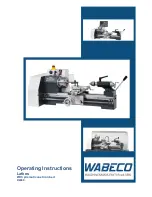
Bevels and chamfers are cut at an angle to the main work-piece surface. A bevel cut
(Figure 23.3) goes from side to side, completely removing the perpendicular edge. A
chamfer removes only part of the perpendicular edge.
Figure 23.3 A bevel cut goes from side to side, completely removing the perpendicular edge.
To cut bevels and chamfers, either move the workpiece into an angular cutter or hold the
workpiece at the desired angle while moving it into a plain cutter or end mill. You may
hold the workpiece in a vise or in a fixture held in a vise.
Squaring a Workpiece
To square the ends of a workpiece, use the peripheral teeth of an end mill. If you want
to remove a lot of material, use a roughing end mill first, then finish to size with a
regular end mill.
Plunge cutting is efficient for removing material quickly on low horsepower. Plunge the
end mill a predetermined width and depth, retract it, then advance and plunge it again
repeatedly. The maximum cutting force is in the machine's strongest (axial) direction.
Milling a Cavity
After laying out the outline of the cavity to cut, rough it out to within 0.030" of the
finished size before making finish cuts. Use a center-cutting end mill for the starting hole.
Tapping
Drill a hole. Then remove the drill bit and put a tap into the chuck. By turning the chuck
slowly by hand with slight downward pressure, you can get a perfectly threaded hole.
23-2
For Assistance: Call Toll Free 1-800-476-4849
Midas 1220 XL Operator’s Manual
Summary of Contents for Midas 1220 XL
Page 6: ......






































